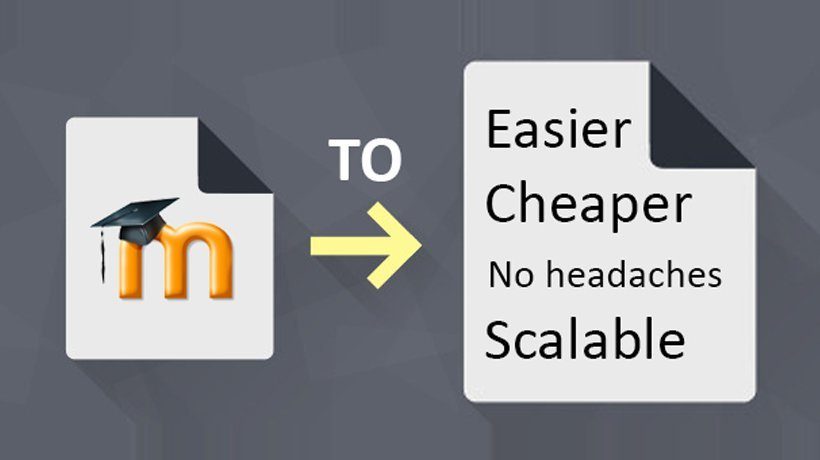Presenting The Origin Of Moodle Learning Analytics And Its Evolution
1998
This was the time when the businesses on the internet were booming at rocket speed. Every day, you saw new ventures springing up like mushrooms until the Dot Com Bubble. In his best-seller, Zero to One, Peter Thiel vividly narrates the situation. So much so you felt like you were there witnessing all-that-soon-to-be mess.
2000
Crash. Crash. The world was brought to its knees with the Dot Com Bubble. However, “There is a blessing in disguise,” whether you believe it or not.
That’s none other than data.
A Diamond Is Forever. So Is Data
With an exponentially increasing number of businesses on the net, there was a search data pile from their visitors. The precious data which is worth a potential 100 billion pounds revenue. Mind-boggling, isn’t it?
Your data has become valuable like a sparkling diamond now. Be it from a search engine or Learning Management System (LMS).
When your gathered data is analyzed systematically, the findings will benefit either you or the entities that aim at you.
During those days, nobody foresaw this startling discovery except Urchin Software, which has developed a forerunner for Google Analytics (Web Analytics).
The Origin Of Moodle And Learning Analytics Development
The internet boom has helped every business in every sector thrive like never before. It opened new avenues like eLearning to the world, which were not there before on the scene. At least, they were not that sophisticated; for example, the 90’s Learning Management System (LMS) from SoftArch which was later acquired by Open Text.
The first open source LMS came into practice at the dawn of the new century. Martin Dougiamas, an Australian educator, authored the initial version of the Modular Object-oriented Dynamic Learning Environment (in short, Moodle) in 2002.
Since then on, the popular LMS has no turning back.
But, how do you know that the eLearning on the Moodle LMS is effective and enhancing you as a learner, teacher/instructor, corporate trainer, whatever special role you play on the LMS?
The answer lies in learning analytics (why not web analytics?).
Reasons For Educators To Measure Learning Experience
Everything is measured whether you know it or not, like it or not. Your eLearning on the Moodle LMS should have no exception if you want to learn, grow and become better at your Moodle Learning and Development (L&D).
The importance of measuring the Moodle learning:
- To gauge whether your course/program is working as you intended it to work
- To identify the top, active and passive learners
- To chart a course of action to engage your passive (or other) learners
- To make a comparative analysis of your courses and learners
- To evaluate instructor/teacher/any other role performance
- To allocate your resources and to see that your spending of the same isn’t going in vain, above all
So, what exactly is learning analytics?
According to the most common definition on the web, the learning analytics consists of:
- Measurement
You have to define what you want to measure from the Learning/Training and Development. You set dimensions (Key Performance Indicators such as top trending courses, no. of enrollments, etc.) and get their metrics (numbers). - Capturing Data
By default, you collect the search (and activities) data on server logs. The collected data in its raw form is indispensable for discovering the actionable insights. - Analysis
This is the crux phase in learning analytics. Based on the KPIs you set, the raw data is segregated and scrutinized for key findings from its database. - Reporting
The reporting visualizes the key findings from the analysis in various forms of graphs, charts, and tables.
Can You Measure Moodle Learning With Google Analytics?
Moodle was in its foundation years (2002–2005) when the search engine giant, Google, foresaw the profound impact of the analytics for any business from any sector on the net.
As a result, Google-owned the Urchin Software application in 2005. And that’s a forerunner for the present Google Analytics.
With its robust presence in data analytics for any business/learning on the net, can’t you measure Moodle learning with Google Analytics?
The answer is: No, you can’t.
Because the Key Performance Indicators (KPIs) you want to measure from the Moodle learning is very much different from that of the common KPIs used by Google. The KPIs (dimensions) like no. page views, avg. time-spent, browser stats, organic keywords, backlinks, etc.
Though those KPIs are very much important for your website, you cannot take the same as dimensions for your Learning Management System (LMS). You need to define altogether new KPIs, depending on what you want to measure from your learners through the L&D (or, T&D).
So, if you want to measure Moodle analytics, you will need to look for alternatives to Google Analytics.
The Alternative: The Measuring Tools For Moodle Analytics
As an alternative to Google Analytics, you have over a half-dozen Moodle learning analytics plugins and integrations. They made your Moodle eLearning magnificent, one step at a time.
Some of those tools are listed here:
- Moodle
- Piwik
- Learning Locker
- Intelliboard
- Zoola
- Watershed
- IAD Learning
A few of them from the list above are integrated with Moodle externally.
9 Problems Involved In Measuring The Moodle Learning Analytics
As a Moodle user among 100 million users, you may find one of these problems relevant in your situation.
- No role-wise, multiple Moodle analytics dashboards. If you question yourself as to why you need role-wise, multiple dashboards, the answer may be this: to enhance personalized learning and as well as your overall Moodle learning experience. Each Moodle user needs a personalized learning space to learn, grow and become better at what she/he does on Moodle.
- Uncustomizable Moodle reporting dashboards. If at all you have multiple dashboards, you can’t customize them. In case you do, it doesn’t come without you paying for the same.
- You cannot add a new dashboard. For example, your need may require you to add a new dashboard. But you are helpless to do so because of some plan restrictions or no such facility at all in the tool you employ.
- Designing Moodle reports is tedious. Even if you are good at technical stuff, still it takes a whale of a time and effort to design a Moodle report with the existing analytics system. In most cases, you don’t have any option to create or customize a Moodle report!
- The tool is not cross DB compatible. In order that the tool to fetch Moodle analytics, you must be using the same database (DB) as that of the tool. Otherwise, either you have to switch to the same DB or put aside the Moodle analytics altogether.
- Not having a responsive design. According to GSMA, 66.72 % of the world own a mobile phone. Having a desktop analytics tool won’t suffice to improve the Moodle learning experience at this age.
- Not an unlimited number of reports to explore Moodle Analytics. The number of reports restricts the use of Moodle learning analytics.
- No Site-wide Moodle Reports. Sometimes (or, depending on your frequency), you will want to obtain the metrics at the Site Level. Most of often you get the reports, but not at the site level.
- Exorbitant monthly subscription plans. Yes, not everyone can actually afford to get and use the analytics and reporting tools. Cost-effectiveness indirectly influences learning analytics and becomes a stumbling block for many Moodle educators.
Did I miss anything to include in the list? Leave a comment below the issue you struggled with the most.
Hips Data Don’t Lie
What do you measure using Moodle learning analytics?
Your eLearning past!
Remember this: when you measure your Moodle learning, you measure your past experience on Moodle for diagnostic measures. That is, the diagnostic-kind-of-analytics helps you find out the following:
- What happened?
- Why did it happen?
Unless you scrutinize your LMS data for insights, you cannot figure out why a certain course is doing well. Or why so and so the learner has scored lower grades.
Now, can we predict what will happen to a certain a course or learner even before it might happen?
It’s a big NO with the present analytical tools. In the ensuing future, you’ll see the predictive-kind-of-analytics with the help of machine learning and Artificial Intelligence.
Moodle Inspire: Inspiring To Continuous Learning
The Moodle HQ has been working on predictive analytics since 2017. They nick-named it as, ‘Project Inspire.’ The Moodle Inspire Analytics aims to find out at-risk-learners, based on their learning activities on the Moodle LMS. So much so it alerts the instructors/admins to take necessary measures to inspire those dropouts.
By the way, the Moodle Inspire Analytics is still evolving. You can follow Moodle HQ for more updates.
In conclusion, the Moodle learning analytics has been evolved and made its mark in eLearning on zillions of Moodle educators and learners over a score year. And it will continue to do so with the advanced analytics and reporting tools.







